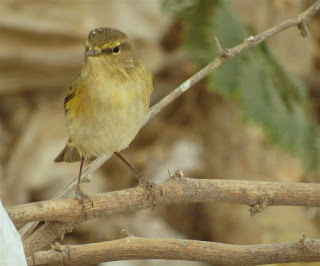My first birding back in Nouakchott after my holiday was in one such sandstorm taking place at the waste water site.
It was tough birding with poor visibility and difficult on the throat. After finishing the session, I went out and bought some surgical masks for future birding this winter.
There was mixed opinion there but most of the expert opinion supported my view.
probable Isabelline wheatear 1
Here are links to pictures to a heavyweight supporter of Isabelline.
http://www.club300.de/gallery/photo.php?id=47961
http://www.club300.de/gallery/photo.php?id=47963
http://www.club300.de/gallery/photo....203&mode=0&i=2
Mauritania falls within the wintering range of Isabelline wheatear but I suspect it is quite scarse as this is my first probable sighiting in two winters. I am surprised how often it is claimed in western Sahara though it is has much more birding.
The day after day of (sandy) winds from the east would make sightings more likely too.
probable Isabelline wheatear 2
Iberian chiffchaff 1
Iberian chiffchaff 2
If it weren't for the sandstorm, the lemon would be clearer still.
southern grey shrike
Most of the time even the southern grey shrike stayed out of exposed positions.
spur-winged lapwing
Two guarenteed birds over the summer and autumn have been spur-winged lapwing and blue-cheeked bee-eater. The former were present but surprisingly quiet. The latter, as predicted, have left and I don't expect them back until July next year.
As I have said before, blue-cheeked bee-eater is not resident in Mauritania contrary to the distribution map in Birds of Western Africa.
Kentish plover
Dunlin
Other waders on the main pool included ruff, wood sandpiper and dunlin.
Eurasian teal
Before I left for my break in early December, there were 16 Eurasian teal at the site. There were exactly the same number of the same species present nearly three weeks later.
Ruff
The ruff were mostly in a hunched posture. The usually long neck was nowhere to be seen.
chiffchaff
little ringed plover
Little ringed plover is nowhere near as common as common ringed plover but two were observed.
At times they were being bullied by a lone common ringed plover. As it was not with the main group of common ringed plover and because its supercilium was weak I spent a lot of time trying to see if I could make it a semi-palmated plover.
common ringed plover
It was not. There was no sign of a yellow eye-ring and the webbing on the feet did not match. I am not particularly fond of tracking waders but it can be rewarding.
wood sandpiper
I am hoping for more comfortable birding this weekend Mohamed Vall and I go south.
Species seen at the waste water site on December 23rd
Eurasian Teal
Common Moorhen
Spur-winged Lapwing
Kentish Plover
Common Ringed Plover
Little Ringed Plover
Ruff
Dunlin
Little Stint
Green Sandpiper
Wood Sandpiper
Laughing Dove
Namaqua Dove
Eurasian Hoopoe
Common Kestrel
Southern Grey Shrike
Crested Lark
Barn Swallow
Common Chiffchaff
Iberian Chiffchaff
Sardinian Warbler
Fulvous Chatterer
Northern Wheatear
Isabelline Wheatear
White Wagtail (alba)
House Sparrow
Sudan Golden Sparrow




























































